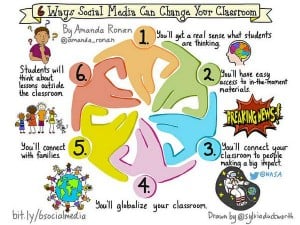I have had some interesting conversations recently about school’s use of social media. Opinions range from the very hesitant and quite wary to very positive and amazingly enthusiastic. I have read articles about the downturn in interest in Twitter, the swaying audience of other tools. They are good conversations and ones I hope to extend by sharing here.
My conversations with teachers usually steer towards the particular tools; Twitter, Facebook, Google+ etc and then a discussion around the purpose behind the activity. The intended consequences are varied but quite easy to define, but it seems that the unintended ones, or the fear of them, are what become the roadblocks to what I have experienced as a wonderful gateway to connections.
There are people much better trained in communication strategies than me but what is clear to me, is that whatever the tool we are using, we are talking about communication and in most cases relationship building. The intended audience will in many ways determine the best tool – who are we trying to connect with and for what purpose? are we intending to broadcast news or promote interaction and feedback?
In today’s world of immediate access to information and news, some older methods of communicating with our communities are becoming defunct or redundant. A weekly printed newsletter is not enough for most of of our parent communications and it will never connect our students to other stakeholders in their learning in the way online communications can.
I maintain and am convinced that if we expose students to the concept and reality of working in a space that is not limited by their physical surroundings, that we are doing them a great service. Our access to information is 24/7 and global and so too should be our learning experiences.
In this short interview, Stephen Heppell is asked for advice to using Social media and my precis is as follows:
- Turn on your common sense
- Acknowledge that ‘acceptable’ behaviour is the same online as face to face
- Research and then trial your own pathway
Listening to Stephen, I heard “Let’s tell a story – Let’s build a story” and it struck me that it is the building part people need to focus on. As a school, we have been using Twitter along side an extensive blogging program for quite some time and I believe we are building our story as a consequence. Different things are happening as a consequence of being connected via social media. Some of the benefits include:
- affirmation of teacher practice through feedback from local and global peers
- drawing on a much wider field of resources
- deepening of experiences by sharing them with other stakeholders
- exposing our students other ways to find answers to questions
- immediate sharing of school events
- we all experience the value of a wider audience for our thinking and the interactions that occur as a consequence
- modelling connected learning
I am very aware that the concept of an online Professional Learning network is entrenched in many people’s lives, but it still does not appear to be the norm and all I can say is that I think that those not involved are missing out.
Note: School based Twitter account @slblackburnsth is managed by teachers only as our students are Under 13. The students contribute ideas and text that is published by staff in a modelling process.
Relevant further reading:
Why are Schools spooked by Social Media
Forget coding – we need to teach kids about digital citizenry (although I don’t agree about forgetting coding)
Thanks again to Sylvia Duckworth for once again synthesising ideas into such a wonderful format and Amanda Ronin.
Postscript (Jan 2016) :
Since writing this, I found this post by Sylvia Rosenthal Tolisano which encapsulates this topic much better than mine.
